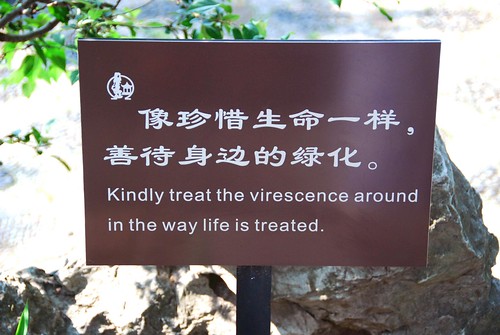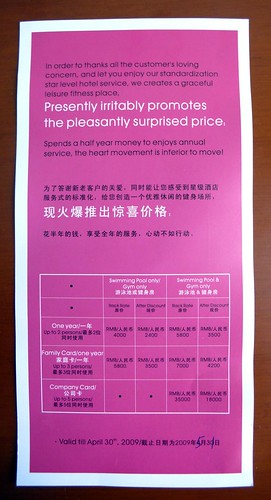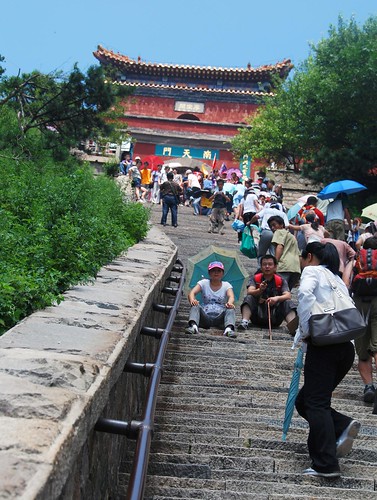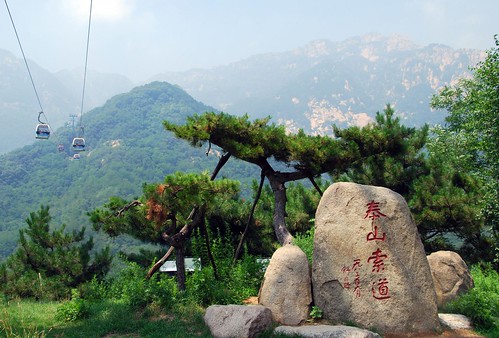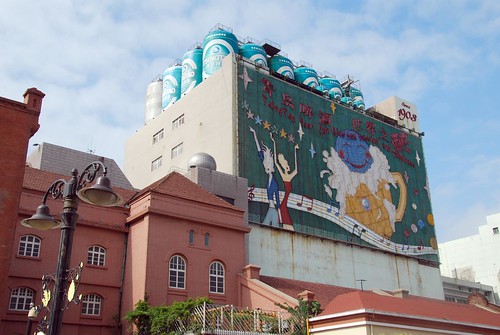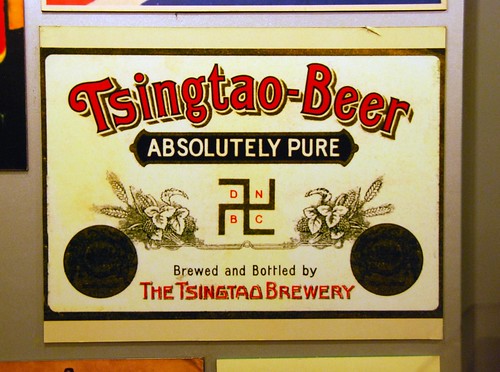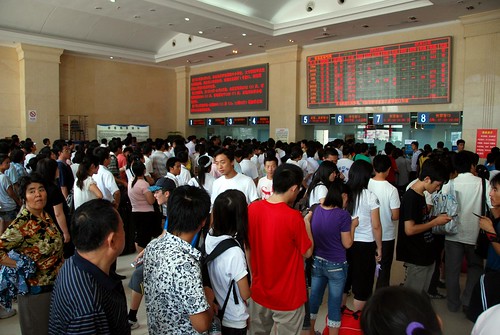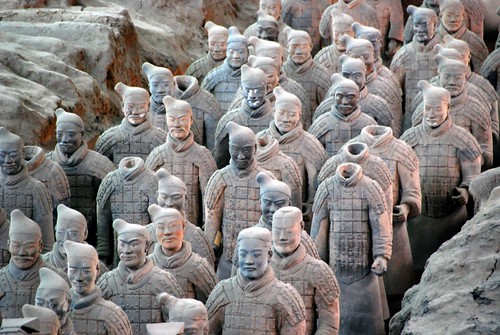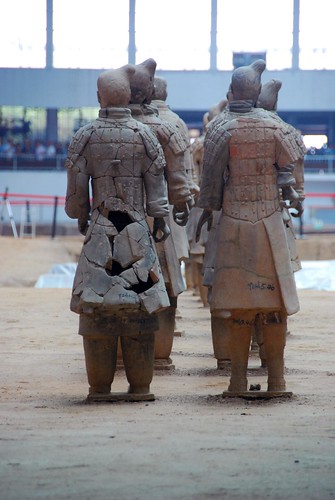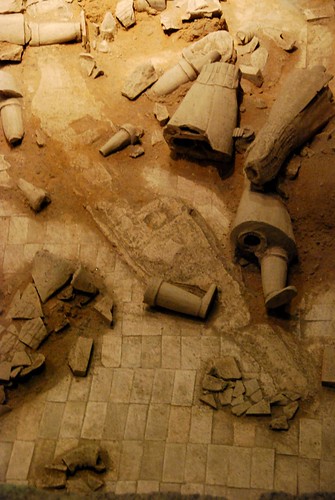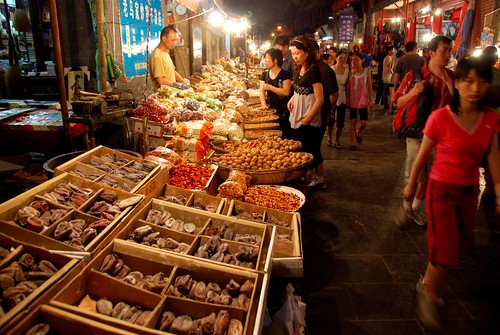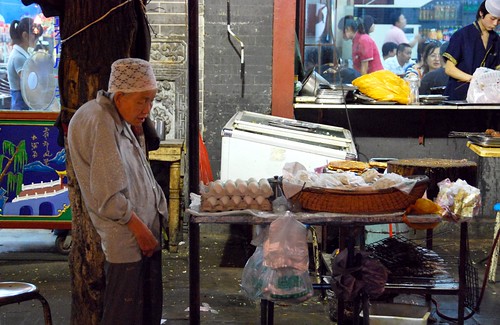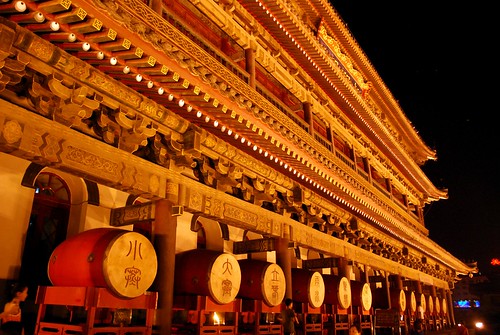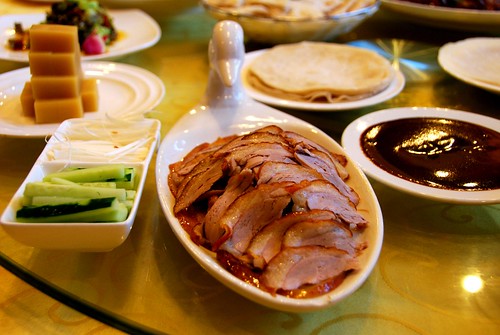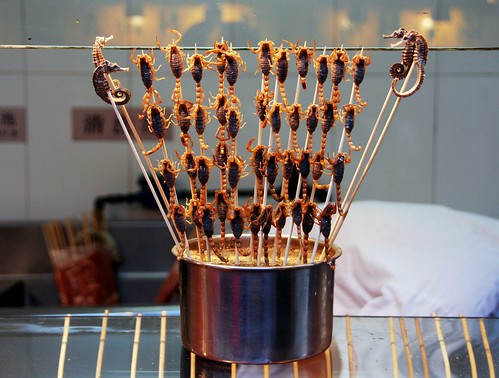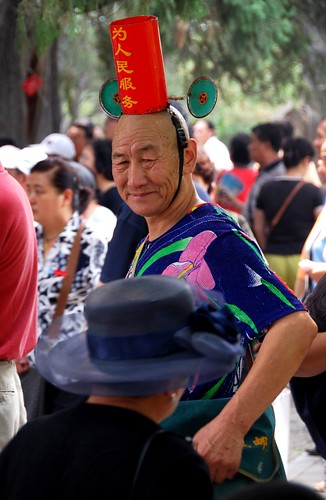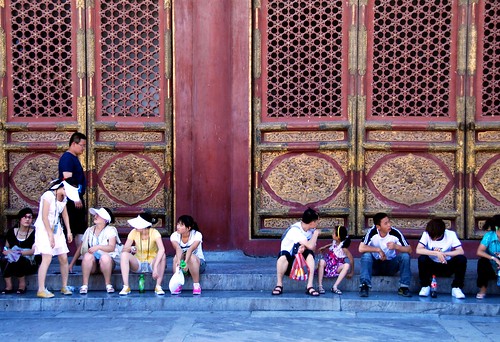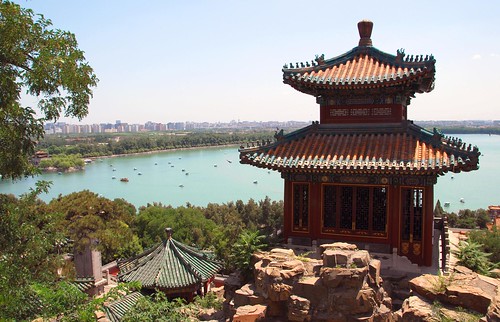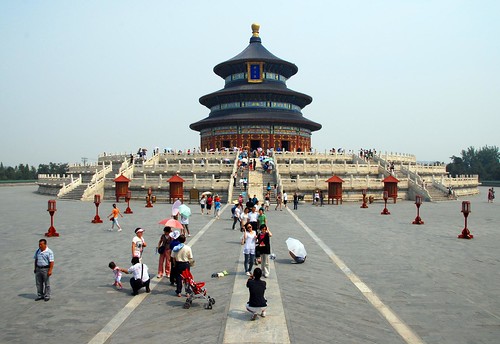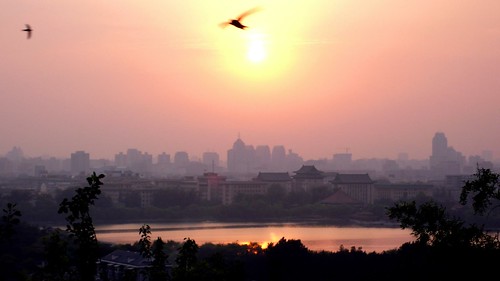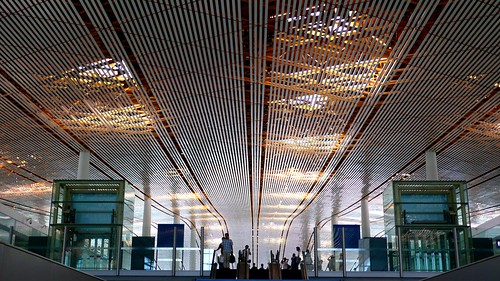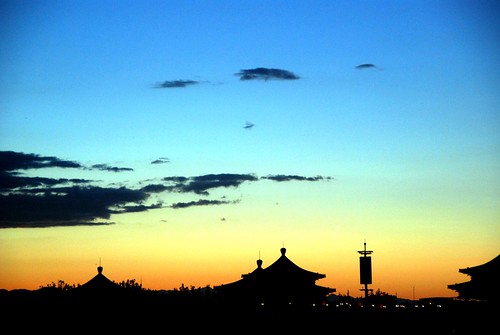Archive for September, 2009
Traveling through China is: Fascinating. At times frustrating. Shocking. Challenging.
And funny.
Yes, the moments of occasional agony will be broken up by daily chuckles and frequent delight. After the frustration has faded from the mind, one memory will persist: the Chinglish.
Chinglish tends to fall into one of three categories; the first being “Inadvertent Misspellings”:
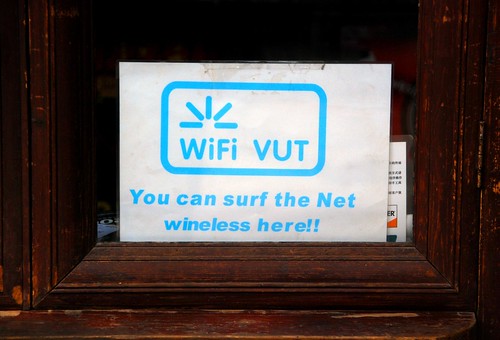
Yes, but do I WANT to surf the internet wineless?!?
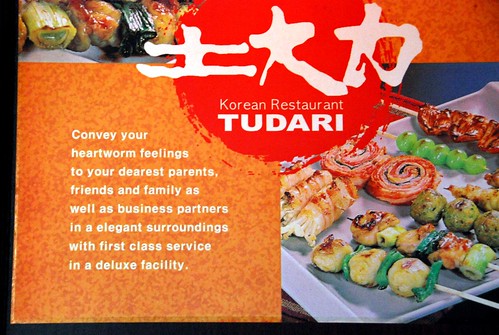
My dearest parents, friends, family, and business partners are definitely going to hear about my heartworm feelings.
Then there’s the “I Get What You Mean, But It’s Not Quite Right” category:
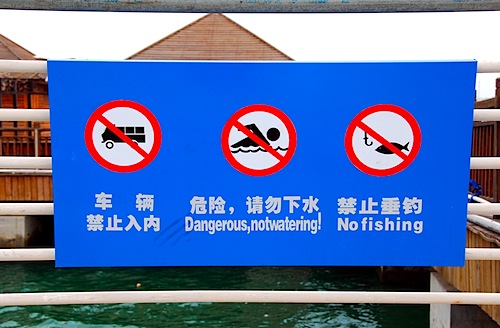
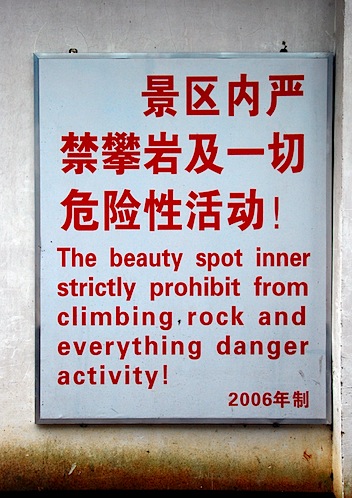
I always try to avoid everything danger activity.

This is where the internet comes from.
And finally, the “I Don’t Even Know What is Going on Here” group:
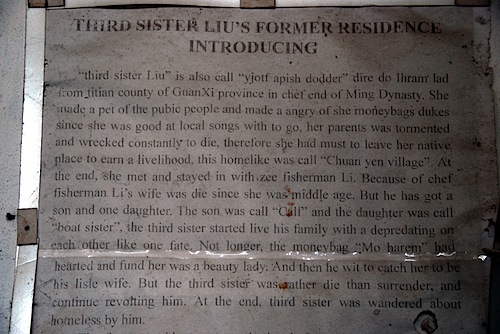
I’m glad my nickname isn’t “yjotf apish dodder.” Also, I am sure the pubic people did not appreciate being made her pet.
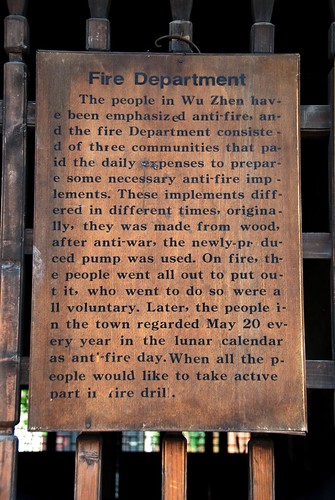
As a graphi-
c designe-
r, this sign r-
eally disturb-
s me.
See the rest of our Chinglish/Engrish photos here:
Northern China’s answer to Huangshan is Taishan, one of China’s 5 most famous mountains. Tons of famous Chinese people—including Mao Ze Dong and Confucius—have summited this holy Taoist mountain, which, frankly, is no small feat, given that the central route up Taishan is pretty much a sweaty Stairmaster workout of 6,660 steps. It is said that if you make it to the top, you will live to 100 years. Not a bad deal, in our opinion.
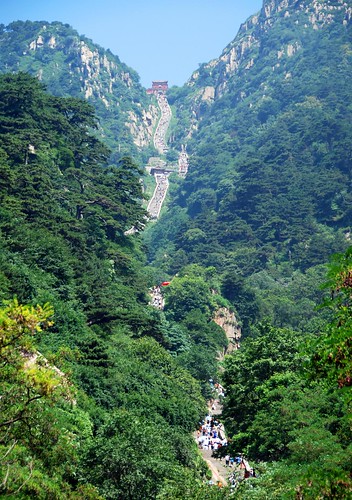
The path to the top of Taishan.
The promise of long life has proven to be enough to get hordes of Chinese people up this mountain, even if they hike it high heels, skinny jeans, or heck, even their underwear.
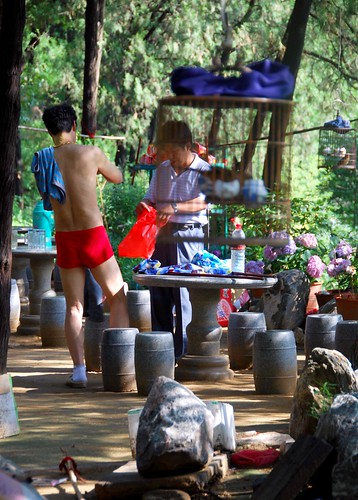
Only in China: Underwear Man hiking Taishan in his manties.
Funny thing is, Underwear Man attracted less attention than Jeremy, who I swear must have been the only wai guo ren on the mountain that day. On top of that, Jeremy took off his shirt (hey, it was hot!), and I don’t know if it was the hairy chest or the shirtlessness or his massive pectorals (Ed note: Jeremy made me write that) that had all the Chinese people picking their jaws up off the ground.
Taishan is very similar to Huangshan in that the sunrise and the cloud ocean are the main attractions. We didn’t see the sunrise this time—staying on the mountain on the mountain is expensive—but we did get enveloped by those famous clouds when we reached the top.
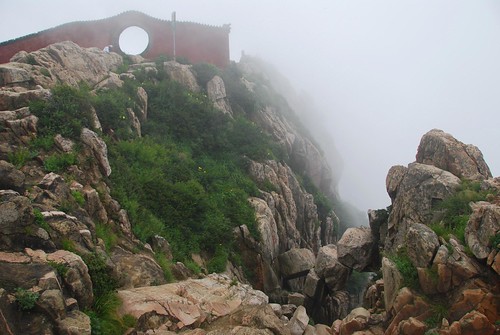
The summit of Taishan enveloped by that famous cloud ocean.
As in Huangshan, people hiking this mountain also superstitiously place locks on the chain link fences as an insurance policy for their marriage. Judging from the amount of locks we saw, it looks like more people hike Taishan than Huangshan, or there are just more suckers in Taishan. ![]()

Locks galore on Taishan’s fences.
Also similar to Huangshan, there are bang bang men hiking up the mountain with bottled water, their repeated trips up and down the mountain permanently warping their skeletons into painful-looking shapes.
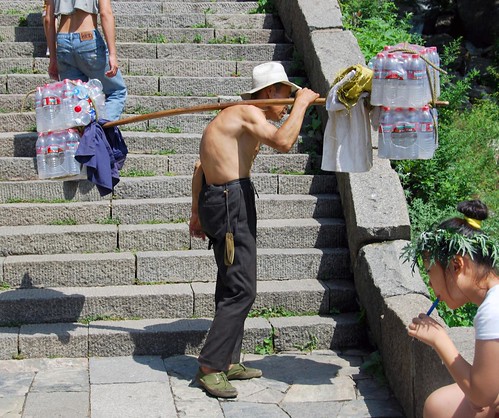
Yet another reason why plastic bottles are bad for humanity.
Hiking Taishan is a fine way to spend the day, though we prefer Huangshan to its norther counterpart. One route up means the stairway becomes very crowded, and given that you can also reach the top via a bus/cable car combo, the summit is swamped with domestic tourists who are still hoping to get their 100 years without breaking a sweat.

The hordes at the top of Taishan.
It took us four hours to hike to the top of the mountain, and a quick 15 minutes to get back down the mountain using the cable car and bus option. Not bad for an extra 60+ years on this extraordinary planet, eh?
Where we slept in Taishan: Actually, we slept in Tai’An, because staying on the mountain was a little too spendy for our budget. No matter, Taishan is easily done as a day trip, though if you want to see the sunrise, you’ll need to spend the dough…or hike through the night (survey says: NO). We booked Dongdu Hotel via ctrip.com for 168 RMB (for a double with bathroom ensuite). Not a bad deal for a three-star hotel. Rooms have little character, but they are spacious, reasonably clean, and some have views of the mountain. Plus, each room has free plug-in internet access and a water cooler dispensing drinking water (a nice touch in China!).
Since Tibet was out as our next destination, where to next? Mongolia? Train tickets were sold out for the entire week. Xinjiang? Tickets also sold out (and thank goodness we didn’t go because the deadly protests in Urumqi broke out a few days later). Here’s how we decided on our next stop: we consulted Weather Underground and looked for the coolest temps in Eastern China. Qingdao it is! Hey, we went to Malaysia for a good bowl of curry, why NOT choose a place based on the climate, especially after the heat in Beijing and Xian made us cry “uncle.”
Qingdao is a former German settlement in Eastern China known for its beach and its beer (which you may know by its Wade-Giles spelling, Tsingtao). It rained pretty heavily while we were there, but honestly, we didn’t care. As long as the the mercury didn’t climb above 90°, we were happy campers.
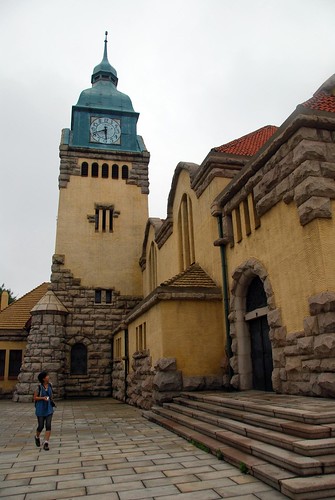
The Protestant Church in Qingdao.
Both German architecture and Chinese people on the beach are novel sights in China, which makes Qingdao a rare place indeed. But the brewery! Totally worth it, even though they were stingy with the free samples (a mere half pint!). The majority of the self-guided tour is pretty standard fare: the history of Tsingtao, different advertising campaigns, bla bla. What made the tour interesting is the actual, functioning bottling plant. I swear Jeremy and I stayed there for half an hour watching them bottle and can the Tsingtao brew. We’re nerds like that.
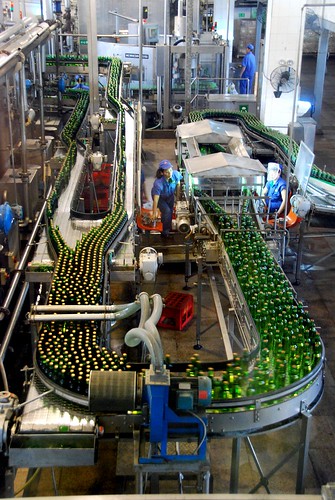
The Tsingtao bottling plant in action.
The other highlight of the Tsingtao brewery tour was the Drunk Room. Basically, it was a room where the floor was slanted. Simple but surprisingly effective! We totally felt drunk (it was BEFORE the tasting room, I swear)!
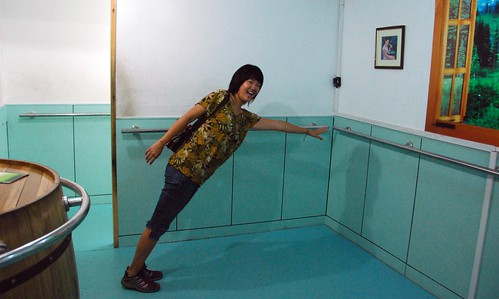
Me in the Drunk Room at the Tsingtao brewery.
I can’t say we loved our time in Qingdao…the city itself is really spread out, and beyond the brewery there isn’t much to do besides wander around the parks (which, I have to admit, are pretty nice), or try to find some German food to eat (surprisingly difficult in Qingdao! We only know of one place: Monnemer Eck, which is was dead empty when we dined there. Good food though!).
But there is one reason why this Chinese city will always stick out in my mind: I had a total meltdown trying to leave Qingdao. Are you ready for this?
We decided on our next destination (Taishan), and learned that there was both a bus and a train that could get us there. The express train left at 6AM, but only took 3 hours. The bus took 6 hours, left several times a day, and was cheaper than the train ticket. So J and I decided on the bus. Only thing is, NOBODY seemed to have any idea what time the bus left. There was no telephone number you could call, no schedule, and the bus station was about 15km north of the city center, so it wasn’t really convenient for us to hop over and ask. Whatever, we’ll just show up at the bus station the next morning, right?
So that’s exactly what we did. We got there around 9:30AM only to find that the next bus leaves at 12:30PM. Not wanting to wait 3 hours in the station, I call the train station and find out that there’s a non-express train leaving at 11AM. We hop in a taxi to the train station and wait in this line for tickets:
By the time I get to the front of the line, train tickets are sold out. Great! Back to the bus we go.
Over at the bus station, the saleslady tells me that tickets for the 12:30PM bus are sold out; next bus is at 3PM. Double great! We have little choice at this point but to wait 4 hours for the next bus. At least there were funny Chinglish signs there to keep us amused.
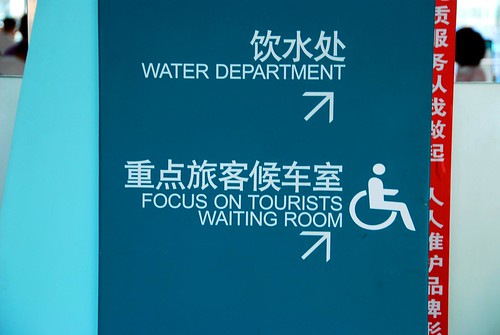
Is this where Chinese people go to stare at the tourists?
At around 2:30PM, I start gathering my things. But hold on a minute…something seems fishy. Why isn’t there a bus at our gate? I examine the ticket (which is all in Chinese), I see the numbers “12:30,” and I start to panic. Did our bus leave at 12:30? Why did the woman at the window tell me 3PM?!? It is possible I misunderstood, but the words for “3:00″ and “12:30″ sound REALLY different in Chinese. So i run up to the information desk, frantic.
Hope: Can you tell me if this ticket is for the 12:30 bus to Taishan? The woman at the window told me it was a 3PM bus!
Information Lady: We don’t have a bus at 3PM to Taishan. This bus left two hours ago.
H: But…but…the woman told me 3PM!
IL: Didn’t you hear them announce that your bus was leaving?
H: I wasn’t listening! I’m not from here!
IL: Well, there are no more buses, you have to leave in the morning.
H: [Almost in tears at this point, and not being coherent] I’m not from here!
IL: [Clearly disturbed by the weird Chinese American girl freaking out] It’s OK, I understand. Here, I can refund your ticket.*
*In retrospect, it was almost unbelievable that she so readily gave us a refund. But I was too distraught to recognize this at the time.
I can’t tell you why I wigged out so badly…the back-and-forth from the bus station to the train station and back again definitely kicked it off, but I think the bulk of it had to do with my growing suspicion that being a Chinese American traveling in China was not an asset, but in some ways a burden. Sure, there are times when it has been awfully convenient to be able to communicate. But there are other times I feel it is easier to have Jeremy’s face in China than my own. I couldn’t shake the feeling that this misunderstanding NEVER would have happened if Jeremy and I were two Western-looking people…they would have tried to find someone who spoke English, or they would have pointed out the time on the ticket.
And maybe that’s why I melted down—because the country to which I have attached my ethnic identity wants almost nothing to do with me. Nobody is trying to take their picture with me (whereas Jeremy’s face must be imprinted on hundreds of memory cards and hard drives around the country). Nobody wants to help me—in fact, sometimes they laugh in my face when I make a “weird” request (like, “can you put some vegetables in my soup?”—what a FREAK!) Or if I don’t understand the phrase they used, they talk about me like I’m not in the room, as if all of a sudden can’t understand anything they are saying. Heck, we even got scammed by my “people.” Do you think a Chinese person would laugh in Jeremy’s face if he mispronounced a word in Mandarin? Doubt it. They’d probably be too busy falling over themselves with adoration.
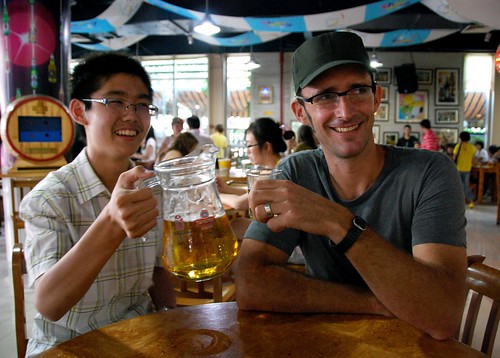
Jeremy posing with yet another unidentified Chinese boy at the Tsingtao brewery.
As a Chinese girl growing up in the USA, I spoke Mandarin at home, went to Chinese school on the weekends, and ate hot pot on Thanksgiving. I thought I was Chinese. Only now, after traveling through the countries of my ancestors, do I find that the truth is much more complicated than that. I find myself grossed out by all the spitting, annoyed with the crowds, irritated by the constant noise, disgusted by the bathrooms…and yet simultaneously, I want to defend this country to the Westerners who complain about the exact same things. I want to explain that Chinese people spit on the floor because they think blowing your nose in a tissue is disgusting. I want to challenge them to live in a country with 1.3 billion people and see what their public bathrooms look like. I want to tell them: just because it’s different doesn’t mean it’s bad.
Oh, the confidence that is inspired by that singular viewpoint!: To always look from west to east and not back in the other direction. Don’t get me wrong—there are many, many gifts that I was bestowed because of my ethnic heritage: a multilingual tongue, respect for my elders, a hair-free body. But that confidence is not one of them.
That day in Qingdao was the only time on the trip I just wanted to click the heels on my ruby slippers and go back home. You know, somewhere I felt like I belonged. Now if I only I knew where that could be…
During the second half of our China trip, Jeremy and I planned on visiting Tibet. The landscape, the people, coupled with our increasing interest in Buddhism, meant that this “autonomous region” in Western China held a strong allure for us. But there are realities to travel in Tibet (besides the obvious political ones), and after doing a bunch of research while we were in Beijing, we decided against the trip. Here’s why.
THE REALITIES
- It’s a long train ride…
…48 hours from Beijing to Lhasa, to be exact. And from all accounts we’ve read, it’s like 48 hours on the Yangzi River Boat (read about our experience here: Three Gorges Yangzi River Cruise: Chinese Immersion School), only sans private bathroom (and if you’ve ever been in a public Chinese toilet, you know that this is no small matter), the aisles are filled with boxes of food and instant noodles (the Chinese love nothing more than to make sure they have enough to eat at all times), and you’re stuck on the train. That being said, it is supposedly a breathtakingly beautiful ride, and if all the other parts of visiting Tibet added up, we totally would have done the trip. But the realities of getting to Tibet are something you really must consider. Sure, you could fly too, but its expensive to do so and you would miss out on seeing the grandeur of the landscape on the way to Tibet. The train track to Tibet is the highest in the world, and each car reportedly contains oxygen masks in case you need help adjusting to the altitude. - The permit application process
Permits have long been required in order to travel to Tibet, and it takes 7 working days to process them, though some places can arrange them for you in as little as 3, while others require a full 10 days. For travelers like Jeremy and I, who barely know where we’ll be tomorrow, much less next week, this restriction did limit our options. Currently, the only way to get a a Tibet travel permit is to sign up for a tour, which brings us to our next point: - In order to travel in Tibet, you must be on a guided tour with the same itinerary as everyone else
Due to the protests in Tibet last year, the Chinese government is being more strict about requiring visitors to be on a tour in Tibet. It used to be that a tour group could consist of 1 person, and we also hear that you used to be able to travel to Lhasa on a tour and then explore the rest of the region independently, but that does not appear to be the case any longer (or if it is an option, it is a very expensive option). We talked to many tour companies, and most itineraries looked identical (with the exception of one Tibetan-based tour company). To make matters worse… - Tibet is a Chinese Disneyland in the summer
The period we wanted to visit Tibet (late July), is tourist high season in Tibet. Every DAY, 12,000 Chinese tourists flood into Lhasa. We just didn’t want our experience of Tibet to be entangled with the pushing crowds and the megaphone-wielding tour guides like so much of China seems to be flooded with these days. In 2009, the Chinese government gave out a large number of travel vouchers to use for domestic tourism in order to stimulate their home economy. Quite frankly, it would kind of break our hearts to see the spiritual center of Buddism turned into a Chinese playground. - It’s not cheap
For the privilege of visiting Tibet, you must be willing to pay at minimum about US$150 per person per day, not including meals. Given that our budget for China was about US$120 per day for the both of us, this really broke the bank. Also, be aware that the cheaper tours are typically offered by government-sponsored travel agencies in Beijing with Chinese (not Tibetan) guides leading the tours, and very little of your US$150 per day will go into the pockets of Tibetans. The government-sponsored agencies are often able to offer lower prices because they have an advantage in procuring train tickets (they are allowed to purchase tickets in big blocks before they are available to the rest of the public…and then sell them to smaller tour operators at marked-up rates).
WHAT YOU CAN DO
We don’t necessarily advocate avoiding a region or country altogether when you don’t agree with the political climate. But we do think it’s wise to do your research and make sure the bulk of your tourist dollars are going to the right places.
- Plan ahead and do your research
Quite frankly, this is where we got stuck…if we would have started researching the Tibet trip earlier, we probably could have made it happen. But waiting until we were in the country to do our planning (which is our normal M.O.) just doesn’t work for Tibet. Read as much as you can on the travel situation, as it can change dramatically from month to month. Here’s an excellent website we found: Life on the Tibetan Plateau. And of course, check out Lonely Planet’s Thorntree Forum. Also, as with any tourism you do, be sure to read up on the local culture so you can be a culturally sensitive traveler! - Make sure you choose a Tibetan operator and get a Tibetan guide
You can make arrangements for your Tibet tour in Beijing, Xian, Chengdu…basically any big city in China. But many of these travel agencies are Chinese-owned, which means very little of your tourist dollars will actually go to the Tibetan people. Make sure your money is benefitting the people who are most affected by your visit and find an agency than actually operates from Tibet. Also, we found that many of the Tibetan-operated agencies had different itineraries, so you won’t be hitting all those gorgeous sights when all 11,999 other tourists in the region are flooding in.
We sincerely hope that the Tibetan travel situation eases up in the future. We would love to one day explore this magical land without the restrictions that have been a reality of the recent past.
I can still remember the first time I heard of the Army of Terra Cotta Warriors: it was in one of my Dad’s 1980’s-era issue of National Geographic. The image of all those soldiers, each one with his own unique facial hair, clothing, and even shoe tread, stayed with me through the years, so I was understandably excited to see the real deal.
The Army is located a few kilometers outside of Xian (sometimes spelled Xi’an), easily reachable by cheap public transport. The complex consists of 3 different pits, with the most extensive excavation in the cavernous pit 1.
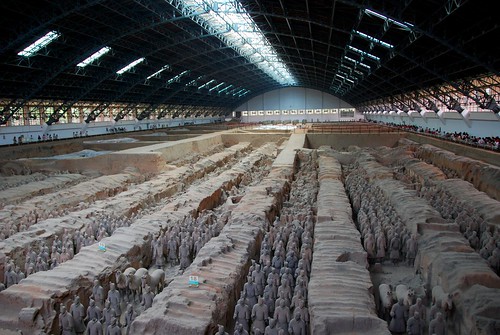
Pit 1, the largest excavation site of the Army of Terra Cotta Warriors.
In pits 2 and 3, you can see excavation work still underway. You can also see where the tomb ceiling has collapsed in parts, crushing some of the figures beneath it.
Nobody knows why the Army of Terra Cotta Warriors exists, and there is something mysterious about the place, especially in pits 2 and 3, where the dim mood lighting adds to the mystery. I mean, why would someone create 8,000 different soldiers and bury them in an underground tomb? Unfortunately, seeing the real deal is probably not much better than watching a really good documentary on the subject. Part of the problem is that you can’t get very close to the soldiers in their natural habitat. Also, the grounds and buildings that the pits are housed in are super modern and, quite frankly, kind of generic and stale…they don’t really match the uniqueness of the site or of the soldiers—you almost forget that you’re at an active excavation site at all! That being said, seeing the soldiers wasn’t a disappointment either…but some famous sites leave you so thrilled that you’d happily revisit in the future, and let’s just say that we’re happy to have seen the Terra Cotta Soldiers once in our lives but we probably don’t need to go again.
Most people spend a day or two in Xian, see the Terra Cotta Soldiers, and move on. We actually ended up getting stuck in Xian—we were right in the middle of tourist high season (in a year when the Chinese government gave out travel vouchers for domestic tourism), and all the onward train tickets to popular destinations were sold out. So, we spent a good number of days exploring Xian, and despite the fact that it was brutally hot, we had a nice time checking out this interesting town.
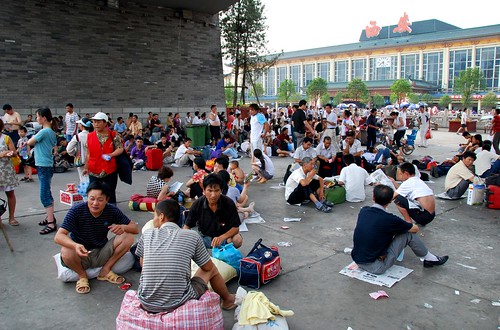
Locals hiding from the sun in front of the train station.
Xian has a large Muslim population, and we were staying right in the midst of the Muslim quarter. We wiled away many an hour (when it wasn’t too hot) wandering around the neighborhood, taking in the local flavor. The Great Mosque, in the center of the Muslim quarter, was fascinating, and we happened to be there during the call to prayer.
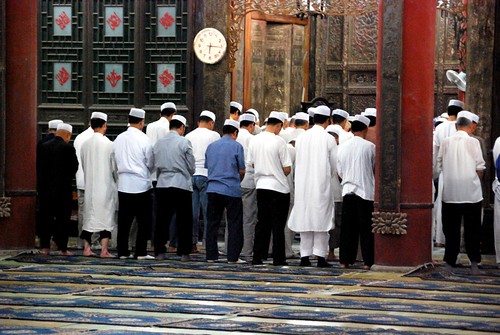
Prayer at the Great Mosque in Xian.
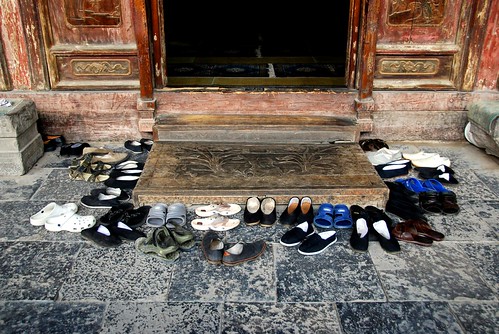
A shoe convention during prayer time at the Great Mosque.
At night, the neighborhood turns into a bustling market with lots of food stalls.
We tried a local specialty called pao mo, which is basically a lamb stew with little bits of shredded bread soaked in the soup. It was delicious, but some of the other Chinese Muslim food we tried was very heavily spiced and it did not agree with Jeremy at all. We ended up spending the rest of our meals trying to find more conventional Chinese fare, which was quite difficult in the Muslim quarter. At one point, we were so desperate that we ate at Subway (though, to our credit, we did pass up Pizza Hut)! I have never seen Jeremy so excited for a 6 inch sub.
Xian actually has a bunch of stuff that would interest a tourist: the Bell Tower, Drum Tower, Big Goose Pagoda, and the Old City Wall, just to name a few.
Unfortunately, it was so incredibly hot while we were there that we spent most of our days waking up early, going out for a few hours until we couldn’t stand it anymore, then hiding in our hotel until the sun went down and the temperatures became bearable again.

This is how hot it was in Xian.
Hey, at least we figured out what our upper temperature threshold is: about 99°F with about 75% humidity. Ouch.
NOTE: We’re switching things up a bit on the picture front! Since you probably don’t want to wait so long to see our photos, and you probably don’t want to see all 5 gajillion photos we’ve taken in a country at the very end, we’ll be adding Flickr slideshows for certain individual destinations! We’ll only do this for select destinations, just to keep you on your toes. ![]()
Check out our photos from Xi’an, China:
Since I already wrote a book about your typical homestyle Northern Chinese fare when we were in Taiwan, I’m not so much going to explore the What (as in What is good) of Beijing cuisine, but rather, the Where (as in Where we ate). The food in Beijing is the best we had in China (though to be honest, the best Chinese food is still over in Taiwan).
First things first: China is a huge country, and there are many regional differences in speech, appearance, and yes, diet. But there is one major difference between the north and the south when it comes to cuisine: the north is all about noodles, and the south is all about rice. This is a common explanation for why people in the north tend to be taller than those in the south (take a wild guess where my freakishly tall family is from). I’m not exactly sure why a noodle-based diet would result in a taller population, but if I had to take a guess, I suppose it’s the egg protein in the noodles. Anyway, because meat was more scarce in the past, and because people in the south eat rice as their carb, southern cuisine tends to be very oily. Hey, people need to get their calories somewhere.
This could be the reason why J and I preferred food in the north. Our Northern California palettes prefer light and fresh over heavy and rich. This is not to say we don’t like rich foods—after all, I wouldn’t exactly describe ramen as “light and fresh.” Rather, we just like our food to taste like itself (we want spinach to taste like spinach and not like oil).
That being said, we ate a whole lot of stuff that tasted like Peking duck while we were in Beijing. ![]()
Our first taste of Peking duck was our meal out with my aunt and uncle at our hotel’s (King Parkview Hotel) adjoining restaurant, which, surprisingly, turned out to be quite good! I’ve had Peking duck in the States before, but it is totally different experience in Beijing. The process begins by choosing a duck, and then a person that I can only describe as a duck surgeon comes out and carves your bird into paper-thin slices.
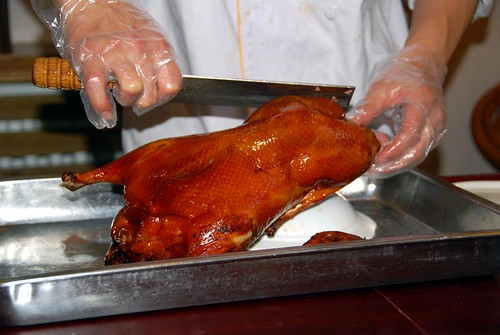
The duck surgeon hard at work in the King Parkview Hotel Restaurant.

My aunt (daughter of my Nai Nai’s older sister) and uncle in front of the Bird’s Nest. Aren’t they cute?
The paper-thin slices of Peking duck are then usually sandwiched between a small piece of bread with some hoisin sauce and additional goodies. In the States, these “additional goodies” consist of spring onion (bo-ring!). But Beijing puts the “good” in “goodies,” as at Hua Jia Yi Yuan on “Ghost Street” or Gui Jie (one of the most famous eating streets in Beijing), where you get all kinds of fun treats, like cucumber, pickles, even pineapple!
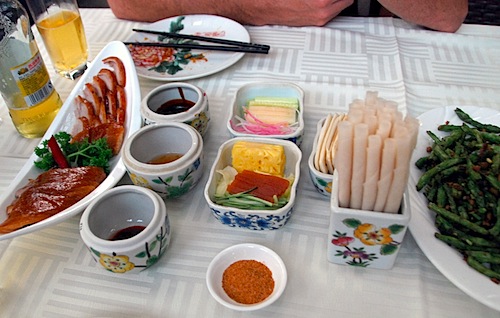
Hua Jia Yi Yuan’s Peking duck toppings.
Gui Jie has a lot of courtyard restaurants, and the atmosphere is fantastic.

The interior of Hua Jia Yi Yuan.
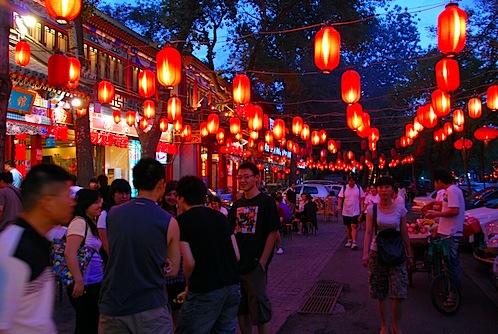
Red lanterns add to the atmosphere on Gui Jie.
We also ate at one of the most popular Peking duck restaurants in all of Beijing: Dadong Duck Restaurant. Our verdict? Unremarkable and overpriced, though you do get free drinks while you are waiting for your table. That’s all we have to say about that.
We enjoyed many a meal by Qian Hai Lake (also sometimes called Hou Hai–the two lakes are adjoined so you can refer to it by either name). Very touristy, but if you look hard enough, you can find budget restaurants. The evening light on the lake is really beautiful, and you can watch locals go for a dip in the water.
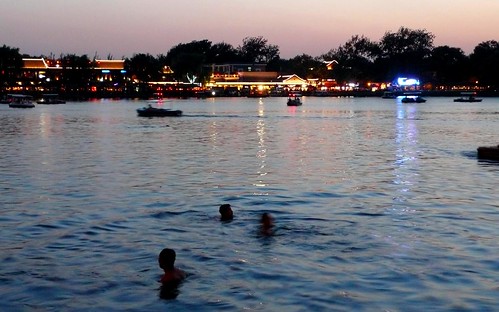
Locals taking a dip in Qian Hai at sundown.
Not all of our meals out consisted of Peking duck. We also had some good, old fashioned jiao zi (dumplings). The best place we ate (by far) was a small shop called Xia’r Lao Man (translation: “Filling Always Full” or “Stuffing Always Stuffed”), where we had jiao zi with pork and fennel stuffing (yum), and an incredible liang ban (cold salad) of cabbage, bean sprouts, cilantro, sesame oil, garlic, and peanuts.
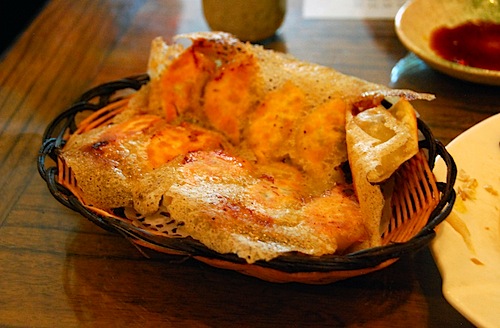
Pork and fennel guo tie (potstickers). They come out of the kitchen like this, the dumplings connected by a solid sheet of fried. Mmm…fried…
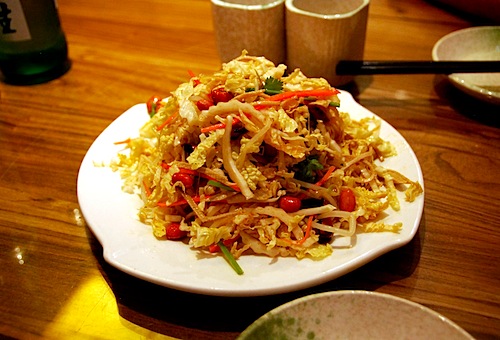
Lao man’r liang ban salad. So refreshing on a hot summer day!
Beijing food just can’t compare to the weirdness of some of the food we ate in the south, or the scariness of the food in Chongqing, but they sure try hard to compete on Wangfujing snack street, where you can get LIVE scorpions on a stick (seriously, they wiggle around on there), topped off with a seahorse.
Of course, if you’re longing to live on the wild side without risking a scorpion sting, you can always order “The palace explodes the diced chicken.”

Or impress your friends by telling them you ate the little-known “Agrocgble aergerita.” With fish heads, of course.

One thing you have to give the Chinese credit for: they don’t hide anything. Part of it is that so much of their lives are lived outdoors. Just walk around the city, and you’ll see so many little intimate moments that are a part of everyday life around here.

How many more minutes until the end of my shift?
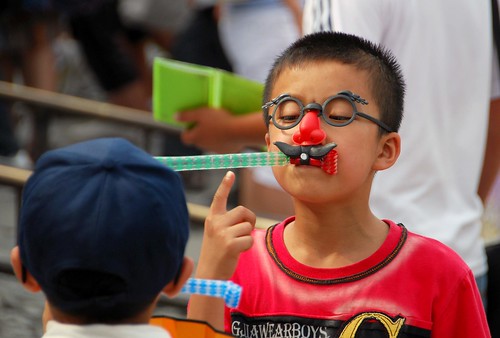
Two brothers square off in Groucho glasses.
One thing that really impressed us here at 12FOOT3: Chinese people really know how to use public spaces. Everywhere you look in Beijing, there are people hanging out, talking, sitting in the shade, playing with the grandkids. I mentioned in our last post that we were charmed by a Sunday spent in the Temple of Heaven Park watching hundreds of people mingling about, doing their Sunday thing (which included ballroom dancing, playing games, singing, hacky sack, calligraphy, and more).
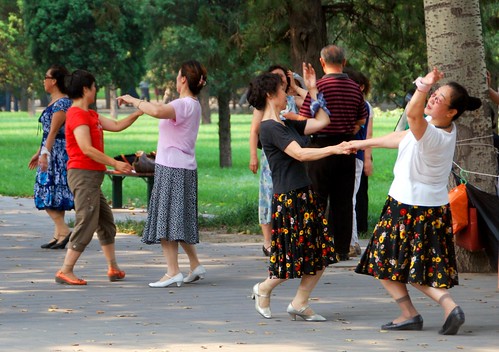
Women ballroom dancing in the park. How cute is it that the two on the right are wearing matching skirts?
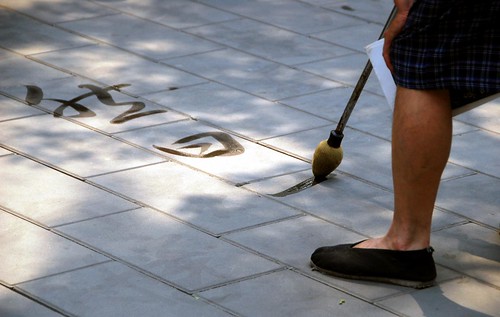
Practicing calligraphy in the park.
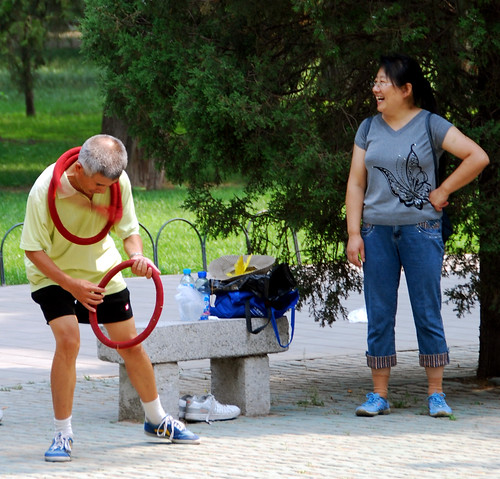
Playing “catch-the-ring.” You play the game in pairs—your partner throws three soft rings from about 100 yards away, and your objective is to catch them around your neck.

As far as we could tell, it seemed like this woman just showed up in the park with a full band, and people wandering through the park spontaneously gathered around them to sing traditional Chinese songs (I even recognized a few from my Dad’s karaoke hits!).
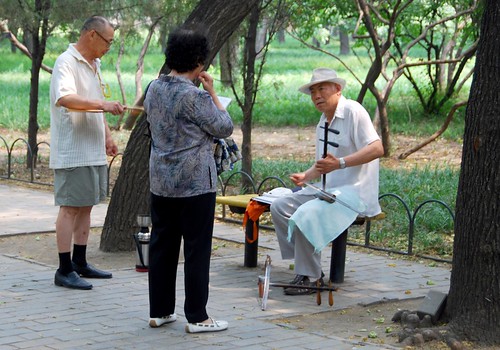
A more intimate version of the big brass band pictured above: just one musician and his dedicated singer.
The other reason why it’s all on display in Beijing is that Chinese people just have different notions of privacy than we do in the west.
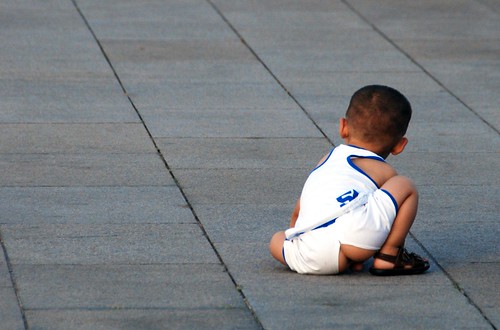
Yes, kids are still wearing the split pants around Beijing. Though I saw a LOT fewer kids wearing these in Beijing than I did in 2000.
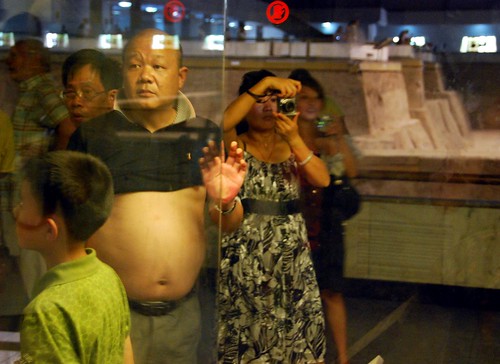
OK, this particular photo was actually taken in Xian, but you see these big Buddha belly guys walking around EVERYWHERE. And I mean everywhere—museums, hotel lobbies, fancy restaurants…
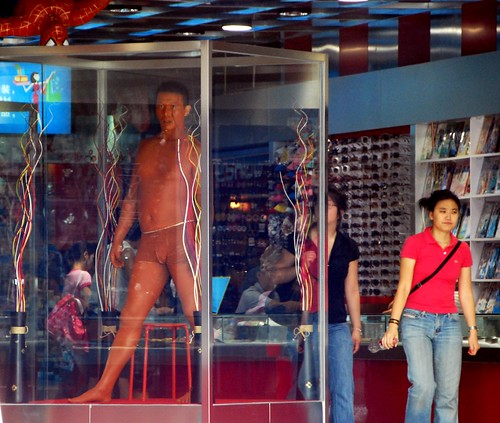
Um, we don’t really know what’s going on here either.
Things HAVE changed around here since the Olympics. For one, people don’t stare…as much (don’t worry, they still stare). I guess they got their fill of wai guo ren’s in 2008. And it does seem that things are a little less raw around the capital city than they were in 2000. There are public bathrooms every two blocks, and they are clean! But the important thing is: the Beijing flavor is still there, and it seems that the Olympics just served to elevate this beautiful city to a more international/cosmopolitan level.
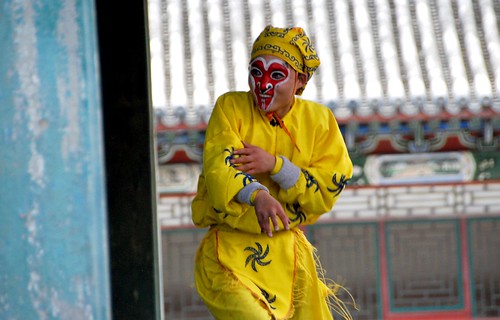
Chinese acrobat at the Summer Palace.
Note: There is a LOT to see and do in Beijing. I mean, it’s almost ridiculous. Not only are there incredible modern and historical buildings to tour, but the culture in China’s capital city is rich and full of life. So for this special city, we’ll be taking a different approach. In a 3-part series, we’ll be sharing the sights, the people, and the food of Beijing with you. We’ll go heavy on the photos and light(er) on the commentary.
If China had a motto, it would be “Go big or go home!” So it makes sense that the sights around China’s capital city are massive. Parks, palaces, walls…you name it, they are share one thing in common: they’re Big (that’s capital “B” Big).
The Forbidden City did not fail to impress, even the second time around (for me, it was the first time for Jeremy). Unfortunately, we showed up at about 10:30AM, which is when most of the tour groups arrive, so our visit was characterized by pushing crowds and tour guides with microphones turned up to “11″ (no fun for my noise- and crowd-averse husband). Here’s a tip: if you ever visit the Forbidden City, go around noon when the tour buses take the masses off to lunch. When we were through checking out the palace grounds, we happened to walk back through the compound (instead of exiting the north side) and NO ONE was around.
Beijing is another city (along with Chongqing and Shanghai) where we have family, and after dinner of Peking duck with my aunt and uncle one night (more on this in the next post), they drove us out Olympic Park. It was really exhilarating to see these gorgeous buildings in real life, especially since Jeremy and I got chills watching the Opening Ceremonies last year on TV. We got really lucky and happened to go on an event night, when the lights were on (apparently the Bird’s Nest and Water Cube are not usually this colorful).
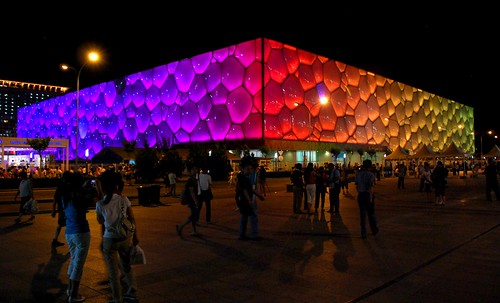
The Water Cube during a rainbow moment. The building’s “skin” is constantly changing color.
When my uncle heard that we planned to visit Simatai (a remote part of the Great Wall) the following day, he arranged for his driver to take us, which was really fortunate for Jeremy and I because it would have taken a LONG time to get there on public transport. Last time I went to the Great Wall, I only saw Badaling, a very touristed part of the wall. Simatai was virtually empty, and we had glorious weather out there: blue sky, fluffy clouds, and a light breeze to cut the summer humidity. Seriously folks, it looked like New Zealand out there!
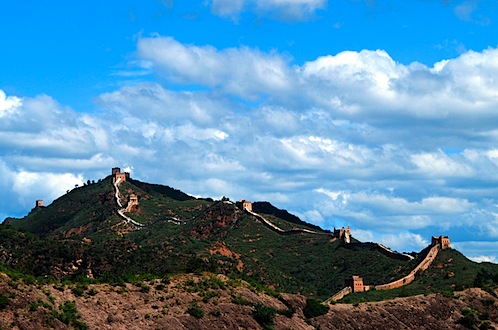
Yes, we had amazing blue skies while we were in Beijing, but Oh. My. God. Was it Hot. So Hot I’m using a capital “H” to describe how Hot it was. The day we visited the Summer Palace (the place where the Empress hung out when it got too scorching in the city), we couldn’t make it more than 10 minutes before taking a break to suck down some water or eat an “Old Beijing popsicle.” They don’t sound that appetizing, but they are cold, sweet, and only cost 1 RMB. We must have eaten at least 6 of those while we were at the Summer Palace.
As for the Palace itself? Impressively large, but a bit over-restored for my tastes. Call me nostalgic, but I like my old things to look old.
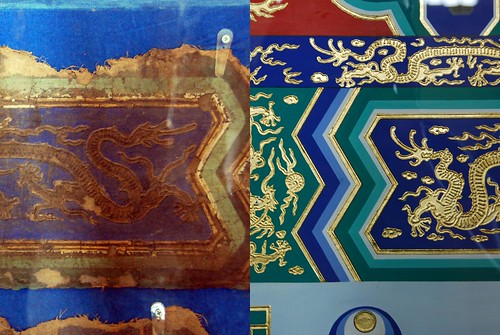
Before and after restoration photos of the paintings around the Summer Palace.
The sprawling Temple of Heaven Park (Tian Tan) was a love/hate thing for us. We adored all the locals hanging out in the park dancing, singing, playing games, and practicing calligraphy, but once we got to the actual tourist destinations (like the Temple of Heaven itself), the tourist crush started up again. Unless you’re really into Chinese architecture, just hang out in the park and soak up the ambience, and skip the actual temples.
Beijing has some wonderful outdoor public spaces. Our hotel was located right next to Jing Shan Park, so we walked through a couple of times to enjoy the fading light over the capital city.
When we weren’t touring “sights” or hiding under the air conditioning of our hotel room, J and I just wandered: in and out of Beijing hutongs, around the shops and restaurants of Houhai or Qianhai lakes, and up and down main thoroughfares, taking in this city of perpetual movement.
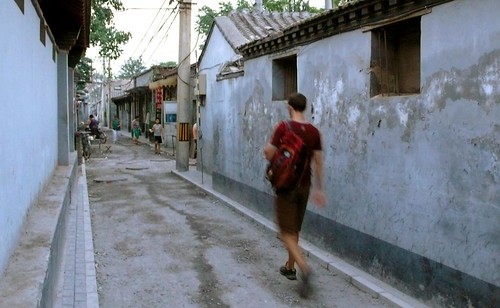
Walking to dinner in the fading light of a Beijing hutong.
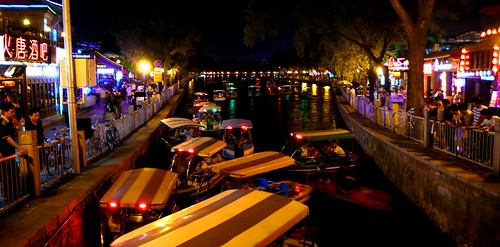
Evening boat jam in Houhai Lake.
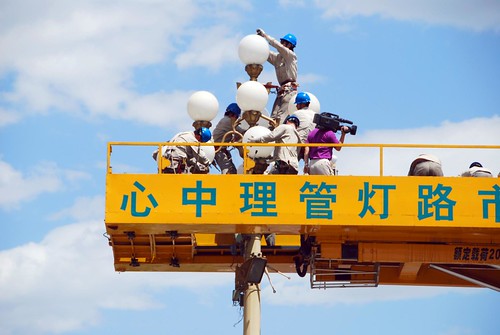
How many Chinese people does it take to change a light bulb?
To be clear: It’s not that Jeremy and I were hesitant about returning to China, but I wouldn’t say that we were excited about it either. It’s always a bit of a downer leaving a country you really enjoy, and after our rude transition from magical New Zealand to Australia, we knew we had to prepare ourselves mentally for our return to the People’s Republic. So we visualized putting our smog goggles back on, honed our elbow reflexes so we could successfully fend off any would-be line cutters, and dusted off the ear plugs.
And then, we saw this from the plane:
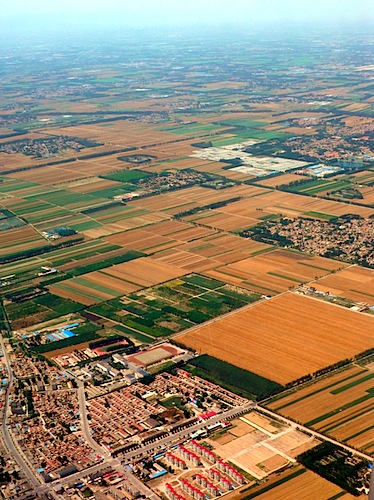
View of the Chinese countryside outside of Beijing.
I told Jeremy, “the airport is really far outside the city, so I bet we’re still outside the smog bank.” Memories from my visit to Beijing in 2000 are clouded by a thick grey cast over the city and the matching tissues when I blew my nose, so I was understandably a bit skeptical.
As we landed, we were told that the Quarantine Authorities would be coming through to check everyone’s temperatures before we deboarded. I tucked in for a long wait at the gate, but true to Chinese efficiency, three QA’s in haz-mat suits got on, shot everyone in the face with a temperature gun, and cleared us to deboard faster than you can say “H-yi-N-yi” (that’s H1N1 in Mandarin).

A quarantion authomite taking face temps on the plane.
We wandered through Beijing’s gorgeous new terminal 3 towards immigration, where the friendly officer spoke to me in perfect English (that was weird…speaking to a Chinese person in English) and marveled at the collection of stamps in my passport.
After quickly clearing immigration, we boarded the comfortable train into town. Less than an hour later, we were headed towards our hotel under gloriously clear skies.
OK, OK. HOLD UP! What is this?!? Nice people, efficient bureaucracy, uncrowded public transport, AND a smogless sky? Did we get off the plane in the wrong country? Is someone playing a really, really mean trick on us?
Well, guess what…all those driving restrictions and factory shut-downs that Beijing put into place for the 2008 Olympics have finally paid off. The sky was crystal clear for our entire 5-day stay in the capital city. I can’t tell you what a difference a blue sky in Beijing makes…our hearts soared, our eyes delighted, and we felt more in tune with this city than any other in China.
We ended that first day with a long walk to watch the sunset in Tiananmen Square. There were police guards all around and you couldn’t loiter at all at the entrance to the Forbidden City. But hey, we’ll trade some subtle military intimidation for a blue sky any day.
